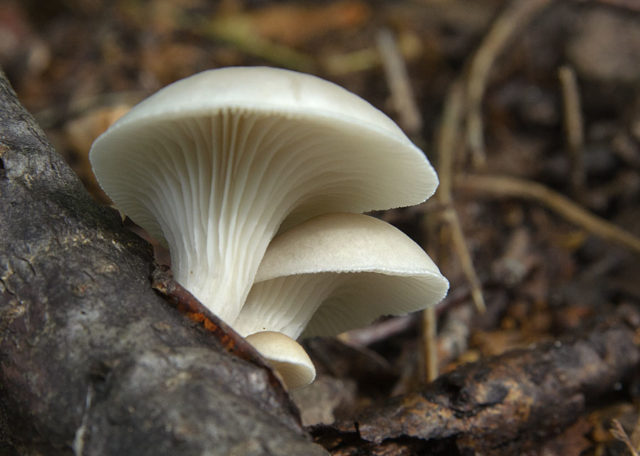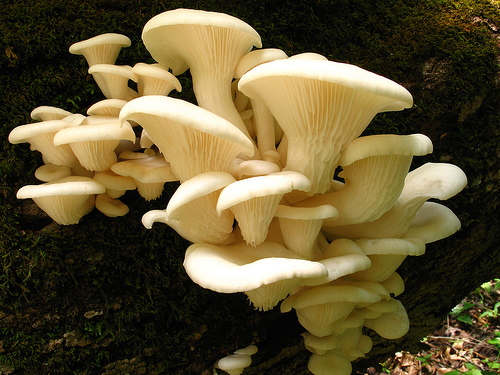Content
Oyster mushrooms (Pleurotus) are a family of lamellar basidiomycetes of the class Agaricomecyta. Their names are determined by the shape of their caps, that is, what they look like. In Latin, pleurotus means "ear", in English-speaking countries they are called "oyster mushroom" due to their resemblance to an oyster shell. In Russia, the name “oyster mushroom” is assigned to mushrooms because they appear in the spring. Of the 30 species of the genus, oyster mushroom is one of the most widespread in the world.

Oyster mushroom has an unusual appearance
Where does oyster mushroom grow?
Oyster mushroom (Pleurotus pulmonarius) grows in tropical and temperate zones of the globe and is found everywhere in Russia. These are saprophytic fungi and form shelf clumps on dead and decaying wood, causing white rot. They prefer broad-leaved tree species - linden, birch, aspen, oak, beech, and are sometimes found on coniferous trees. They grow on trunks or on the ground at the roots. Successfully cultivated by humans. The photo and description of oyster mushroom presented below will help distinguish it from similar mushrooms.
What does spring oyster mushroom look like?
Oyster mushroom (whitish, beech, Indian, phoenix) forms cap-shaped fruiting bodies collected in rosettes. The cap is wide, from 4 to 10 cm in diameter, tongue-shaped or fan-shaped with a thin, tucked, often wavy or cracked edge. The skin is smooth, white or slightly creamy, or may be pale brown. The pulp is white, dense, thin. The plates are light, of medium thickness, frequent, descending. The leg may be absent or in its infancy. If it is present, it is short, thick, formed, cylindrical, lateral or eccentric, tomentose-pubescent. Its color is slightly darker than that of the cap, its structure is dense, even a little hard with age. The spores are white. The mushroom has a pleasant taste and aroma and bears fruit in May-October.

Insects do not touch young oyster mushrooms
Is it possible to eat oyster mushrooms?
Oyster mushroom has a wide range of nutritional and medicinal properties:
- is an excellent source of protein, carbohydrates, fiber and has little fat;
- contains a large amount of vitamins and minerals, its consumption has a positive effect on the human body;
- has antimicrobial, antiviral and fungicidal activity;
- Helps reduce blood pressure, cholesterol and blood sugar.
Polysaccharides contained in these spring mushrooms exhibit antitumor activity against certain types of sarcomas and cervical cancer.
False counterparts of oyster mushroom
All species of the Pleurotaceae family have common external characteristics: it is sometimes difficult to determine their species. All of them are edible and there will be no problem if, instead of one subspecies, another gets into the mushroom basket. But there are also inedible specimens similar to them. They belong to other genera. There are no poisonous varieties among them.
Orange oyster mushroom (Phillotopsis nidulans)
A representative of the family Oryadovaceae or Tricholomovaceae, it is also called Phyllotopsis nested. It has a cap with a diameter of 20-80 cm, fan-shaped, with a characteristic densely pubescent surface. The fruiting body of the mushroom is bright orange or yellowish-orange. The flesh is slightly pale, the plates are brighter than the surface of the cap. The stem of Phyllotopsis nest-shaped is absent. The pulp has a bitter taste and unpleasant odor. It bears fruit in the fall - September-November.
Crepidotus crocophillus
In everyday life, this mushroom is called “sunny ears.” The fruiting body consists of a small (up to 5 cm) cap, which is attached to the wood by the edge. It is semi-round, with a finely scaly orange-brown or light brown surface and a smooth, tucked edge.The pulp is sweetish or bitterish, odorless.
Wolfsaw or felt leaf (Lentinus vulpinus)
It differs from the edible mushroom in its yellowish-brown or beige color, felt-like surface and uneven edge of the cap. The fruiting body of the mushroom is tougher and rougher.
Collection rules
Oyster mushrooms grow in the warm season - from April to September. It is better to pick mushrooms when they are young; with age, the flesh becomes tough and the taste deteriorates. They need to be cut off with a knife, and the entire splice at once. Preference should be given to those in which the diameter of the caps of the largest specimens does not exceed 10 cm. When cutting out the joint, there is no need to leave small mushrooms: they will not grow and will die. During collection, oyster mushrooms must be immediately placed in containers for transportation: repeated transferring leads to loss of the mushroom’s presentation. Fresh mushrooms can be stored in the refrigerator for no more than 4 days.

These mushrooms are most suitable for collecting and cooking.
How to cook oyster mushrooms
Oyster mushroom is a universal mushroom. It is prepared separately and mixed with other mushrooms. They put it in soups, use it as a filling for dough products, make aromatic sauces based on it, dry it, salt it, pickle it, and bake it. You should wash the fruiting bodies very carefully - they are very fragile. There is no need to remove the skin. There is no need to boil them before frying or baking. This mushroom is very popular in Japanese, Korean, and Chinese cuisines.
Conclusion
Oyster mushroom is a good edible mushroom. It belongs to the few varieties of the family that are grown commercially. Oyster mushroom grows very quickly and is undemanding in care.Optimal conditions are temperature 20-30 ˚С, humidity 55-70% and the presence of lignocellulosic substrate: sawdust, leaves, straw, cotton, rice, corn and other plant waste. Many people grow oyster mushrooms for personal use at home or in their garden plots.











